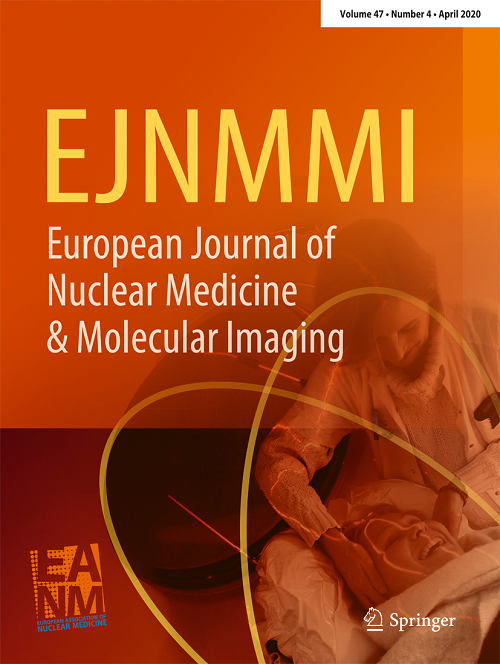长轴位68Ga-PSMA-11 PET比短轴位PET在前列腺癌诊断中的优势:一项头对头的比较
IF 7.6
1区 医学
Q1 RADIOLOGY, NUCLEAR MEDICINE & MEDICAL IMAGING
European Journal of Nuclear Medicine and Molecular Imaging
Pub Date : 2025-09-27
DOI:10.1007/s00259-025-07546-y
引用次数: 0
摘要
背景与目的前期研究表明,与短轴向视场(SAFOV) 68Ga-PSMA-11 PET/CT相比,长轴向视场(LAFOV) 68Ga-PSMA-11 PET/CT对前列腺癌的检出率显著提高。然而,两种扫描之间的诊断效率是在不同的队列中比较的,而不是直接在同一患者中比较。LAFOV 68Ga-PSMA-11 PET是否可以改善图像质量,增强病变量化,并影响同一患者的治疗决策尚不清楚。为了弥补这一研究空白,我们在同一前列腺癌患者队列中对LAFOV和SAFOV 68Ga-PSMA-11 PET进行了直接比较,以评估与SAFOV 68Ga-PSMA-11 PET相比,LAFOV 68Ga-PSMA-11 PET是否能增强病变识别和改善临床管理。方法纳入34例例行68Ga-PSMA-11 PET/CT的前列腺癌患者,并进行当日双扫描方案。一半的患者首先使用连续床上运动进行临床常规SAFOV PET扫描,随后立即进行LAFOV PET扫描(在列表模式下5分钟获取);另一半则以相反的顺序进行扫描。采用主观评分法和客观参数法比较LAFOV和SAFOV 68Ga-PSMA-11 PET的图像质量。测量并比较客观参数,包括最大和平均标准化摄取值(SUVmax和SUVmean)、信噪比(SNR)和肿瘤与背景比(TBR)。结果slafov 68Ga-PSMA-11 PET在主客观指标上均优于SAFOV PET。与SAFOV PET相比,LAFOV 68Ga-PSMA-11 PET具有更好的图像质量和更高的病变SUVmax、信噪比和TBR。在17.65%的患者中,LAFOV 68Ga-PSMA-11 PET检测到SAFOV 68Ga-PSMA-11 PET未识别的额外病变。与SAFOV 68Ga-PSMA-11 PET相比,LAFOV 68Ga-PSMA-11 PET在33.33%的生化复发患者和9.09%的新诊断前列腺癌患者中检测到额外病变,导致临床管理发生了显著变化。结论:与SAFOV 68Ga-PSMA-11 PET相比,LAFOV 68Ga-PSMA-11 PET在前列腺癌生化复发和新诊断患者的临床治疗中表现出更好的图像质量,增强了病灶检测,并对临床管理有显著影响。这些发现提示,LAFOV 68Ga-PSMA-11 PET可能是综合评估前列腺癌的首选成像方式。本文章由计算机程序翻译,如有差异,请以英文原文为准。
Superiority of long axial field-of-view 68Ga-PSMA-11 PET over short axial field-of-view PET in prostate cancer: a head-to-head comparison.
BACKGROUND AND PURPOSE
Previous studies have shown that long axial field-of-view (LAFOV) 68Ga-PSMA-11 PET/CT can significantly improve the detection rate compared to short axial field-of-view (SAFOV) 68Ga-PSMA-11 PET/CT in prostate cancer. However, the diagnostic efficiency between the two scans was compared in different cohorts, not directly within the same patients. Whether LAFOV 68Ga-PSMA-11 PET could improve image quality, enhance lesion quantification, and impact patient treatment decisions in the same patients remains unclear. To address this research gap, we performed a direct comparison of LAFOV and SAFOV 68Ga-PSMA-11 PET in the same cohort of prostate cancer patients to evaluate whether LAFOV 68Ga-PSMA-11 PET could enhance lesion identification and modify clinical management compared to SAFOV 68Ga-PSMA-11 PET.
METHODS
Thirty-four patients with prostate cancer undergoing routine 68Ga-PSMA-11 PET/CT were included and underwent a same-day dual-scanning protocol. Half of the patients first underwent a clinically routine SAFOV PET scan using continuous bed motion, followed immediately by LAFOV PET (5-minute acquisition in list mode); the other half underwent scanning in the reverse order. The image quality of LAFOV and SAFOV 68Ga-PSMA-11 PET was compared using subjective scoring and objective parameters. Objective parameters, including maximum and mean standardized uptake values (SUVmax and SUVmean), signal-to-noise ratio (SNR), and tumor-to-background ratio (TBR), were measured and compared.
RESULTS
LAFOV 68Ga-PSMA-11 PET exhibited superior image quality compared to SAFOV PET based on both subjective and objective parameters. LAFOV 68Ga-PSMA-11 PET had better image quality and higher lesion SUVmax, SNR, and TBR compared to SAFOV PET. In 17.65% of patients, LAFOV 68Ga-PSMA-11 PET detected additional lesions that were unidentified on SAFOV 68Ga-PSMA-11 PET. Compared to SAFOV 68Ga-PSMA-11 PET, LAFOV 68Ga-PSMA-11 PET detected additional lesions in 33.33% of patients with biochemical recurrence and 9.09% of patients with newly diagnosed prostate cancer, leading to significant changes in clinical management.
CONCLUSIONS
In this head-to-head comparison, LAFOV 68Ga-PSMA-11 PET demonstrated superior image quality, enhanced lesion detection, and a significant impact on clinical management for both biochemical recurrence and newly diagnosed prostate cancer patients compared to SAFOV 68Ga-PSMA-11 PET. These findings suggest that LAFOV 68Ga-PSMA-11 PET may be the preferred imaging modality for comprehensive prostate cancer evaluation.
求助全文
通过发布文献求助,成功后即可免费获取论文全文。
去求助
来源期刊
CiteScore
15.60
自引率
9.90%
发文量
392
审稿时长
3 months
期刊介绍:
The European Journal of Nuclear Medicine and Molecular Imaging serves as a platform for the exchange of clinical and scientific information within nuclear medicine and related professions. It welcomes international submissions from professionals involved in the functional, metabolic, and molecular investigation of diseases. The journal's coverage spans physics, dosimetry, radiation biology, radiochemistry, and pharmacy, providing high-quality peer review by experts in the field. Known for highly cited and downloaded articles, it ensures global visibility for research work and is part of the EJNMMI journal family.

 求助内容:
求助内容: 应助结果提醒方式:
应助结果提醒方式:


